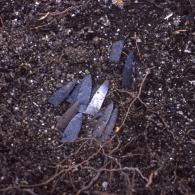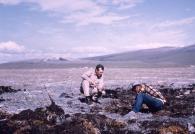The Haffenreffer Museum of Anthropology and the National Park Service have signed a 3-year Cooperative Agreement to inventory and rehouse the National Park Service’s Alaskan archaeological collections curated in the Haffenreffer Museum’s Circumpolar Laboratory.
 Researchers from Brown University’s Haffenreffer Museum and Department of Anthropology have conducted archaeological field research in northwestern Alaska since the 1940s, recovering collections that span nearly 13,000 years, document the emergence of the earliest maritime hunting communities in the Arctic, and trace the histories of Alaska’s contemporary Iñupiat people. The Haffenreffer Museum and the National Park Service look forward to continuing this long-standing relationship with Alaska’s Native communities through the collaborative maintenance of this significant Arctic collection.
Researchers from Brown University’s Haffenreffer Museum and Department of Anthropology have conducted archaeological field research in northwestern Alaska since the 1940s, recovering collections that span nearly 13,000 years, document the emergence of the earliest maritime hunting communities in the Arctic, and trace the histories of Alaska’s contemporary Iñupiat people. The Haffenreffer Museum and the National Park Service look forward to continuing this long-standing relationship with Alaska’s Native communities through the collaborative maintenance of this significant Arctic collection.
The majority of the collections curated at the Haffenreffer Museum were recovered during excavations at three locations in northwestern Alaska: Cape Krusenstern and the Choris Peninsula, both on the shores of the Chukchi Sea, and the deeply stratified Onion Portage site, an important caribou crossing location on the Kobuk River. These collections represent the life’s work of two of the Western Arctic’s most influential archaeologists – J. Louis Giddings, the Haffenreffer Museum’s first Director, and Douglas Anderson, Director of the Circumpolar Laboratory – and provided the foundations for present knowledge of Western Arctic prehistory. Cape Krusenstern National Monument and Kobuk Valley National Park were both established in part due to their research and the national importance of these remarkable sites. Their collections and research remain sources of inspiration from which new discoveries continue to be made.
 The Cooperative Agreement with the National Park Service will allow the Museum to: (1) conduct a comprehensive inventory of the Alaskan archaeological collection currently in the care of the Haffenreffer Museum, (2) assess the condition of the items, (3) rehouse part of the collections, and (4) contribute to their proper long-term care and management, ultimately making them more accessible to researchers, the American public, and especially the Alaskan communities whose heritage they represent. The field work that produced the collections was done on federal lands under federal permits, and archaeological collections obtained in this context remain the property of the federal government. It is common practice that non-federal repositories, such as the Haffenreffer Museum, care for artifacts and samples collected under federal permit.
The Cooperative Agreement with the National Park Service will allow the Museum to: (1) conduct a comprehensive inventory of the Alaskan archaeological collection currently in the care of the Haffenreffer Museum, (2) assess the condition of the items, (3) rehouse part of the collections, and (4) contribute to their proper long-term care and management, ultimately making them more accessible to researchers, the American public, and especially the Alaskan communities whose heritage they represent. The field work that produced the collections was done on federal lands under federal permits, and archaeological collections obtained in this context remain the property of the federal government. It is common practice that non-federal repositories, such as the Haffenreffer Museum, care for artifacts and samples collected under federal permit.
Kevin P. Smith (Deputy Director and Chief Curator) is the Principal Investigator for the Haffenreffer Museum, and Kathryn Myers (Museum Curator, National Park Service) is the Agreement Technical Representative for the National Park Service. The National Park Service has allocated $97,011 from its budget that will allow the Museum to hire a full-time project coordinator for one year, employ students from Brown to assist in the project, and acquire museum-quality cabinets to start rehousing the collections. Although this is a three-year Cooperative Agreement, funding for subsequent years depends on annual decisions surrounding the federal and departmental budgets. The search for a Project Coordinator is underway, and the inventory is set to begin later this fall.
These collections have been an invaluable resource to scientists, historians, and researchers for the past sixty years. With help from the National Park Service in this three-year Cooperative Agreement, the Museum is looking forward to stewarding these collections and making them increasingly available for new research, new insights, and the public good.